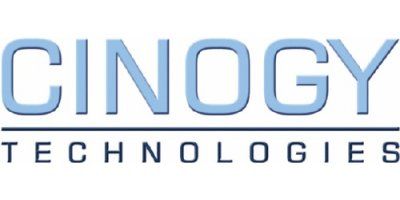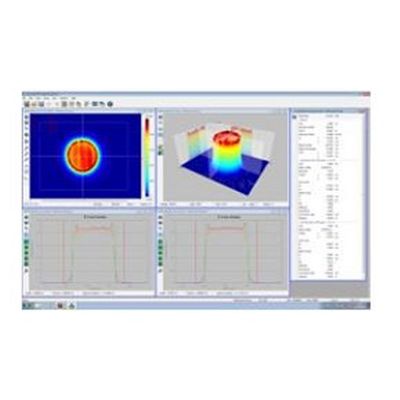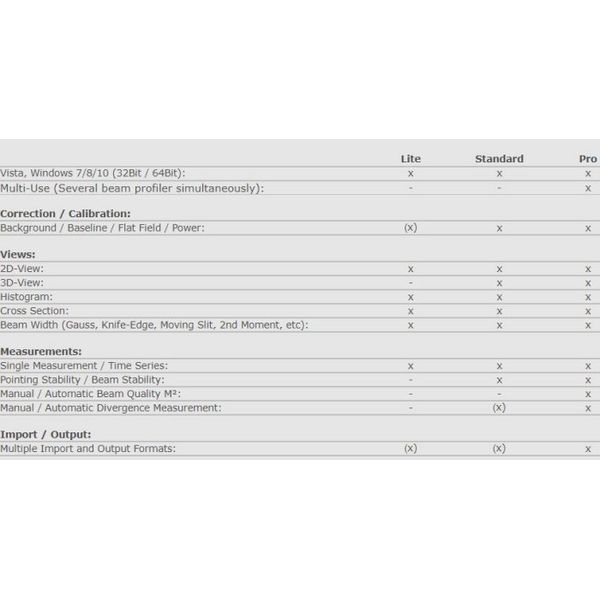

- Home
- Companies
- CINOGY Technologies GmbH
- Software
- CINOGY Technologies - Version RayCi - ...

CINOGY Technologies - Model RayCi - Beam Profiler Software
CINOGY’s beam profilers are available with the specifically designed beam profiling software RayCi, which utilizes new developed correction algorithms and incomparable visualizations modes. This ensures the highest accuracy in beam profile analysis according to ISO standards.
- Available as 32 Bit / 64 Bit version
- Multiple beam profilers support (up to 8 beam profiler on one PC)
- New ‘CinCal’ algorithm for highest measurement accuracy
- Pixel correction technology
- Calibration and correction tool: Background / Baseline / Flat Field / Power
- Real-time beam parameter and beam pointing control
- Real-time beam width and statistic determination
- Automatic tool for fast and reliable beam quality M² / divergence measurements
- RayCi-Lite
- RayCi-Standard
- RayCi-Professional
- ISO 11145
- ISO 11146
- ISO 11554
- ISO 11670
- ISO 13694
Incomparable visualization modes, extensive analytical capabilities as well as new developed correction algorithms ensure the highest accuracy in laser beam analysis. A wide range of beam width techniques can be applied to determine quick and reliable standard beam parameters. The unique measurement tool enables the continuous monitoring of beam parameters, beam position, beam quality and power density distribution.
The extraordinary graphical and analytical tools of RayCi can be used for live data and stored data simultaneously. Helpful features like tracking functions, coordinate system adjustment, zoom functions, Look-Up Tables, etc. simplify the laser beam analysis.

Percentage of Peak:
RayCi supports the most commonly used ‘percentage of peak’ method to determine the width from the beam cross section line. Therefore, two opposite markers are positioned automatically to the specified intensity level. The distance between the markers are used to define the beam width. Two pairs of markers can be used simultaneously to compare different settings.
To expand the beam analysis level and roughness options with statistical values are available.
- 50% - 50% (FWHM)
- 10% - 10%
- 1/e - 1/e
- 1/e2 - 1/e2
- User defined values
Edge Steepness:
Cross section lines of beam profiles are of particular interest for further beam analysis. Especially for flat-top beams the knowledge of the edge steepness is of great importance. RayCi defines the edge steepness of such beams by using different options.
- Edge Steepness Right
- Edge Steepness Left
- 10% - 90%
- User defined values
RayCi supports several 2D techniques to determine the beam width of a laser beam. The customer can choose the best technique for their application. This extensive tool on beam width techniques is unique on the market for laser beam profiling.
2nd Moments (D4s)
Based on the ISO international standard definition for beam width. It describes the variance of the intensity distribution related to the Center of Gravity.
Gauss / Super Gauss
Based on a mathematical model to find the best fitting function for the two-dimensional intensity distribution of the beam.
Plateau / Geometry / Area
Based on a geometrical model to find the best fitting shape of the beam.
Knife Edge / Moving Slit
Based on classical measurements with knife-edge or moving slit.
2D View
- Intensity profile of live and save data
- Look-Up Table / Auto contrast
- Adjustable coordinate system
- AOI adjustment / AOI tracking / Zooming
- Analysis: 2D beam width / Centroid
- Multiple import and export formats
3D View
- Intensity profile of live and save data
- Rotating / Linking / Zooming
- Beam width / Fits / Projections / Coordinate system
- Multiple import and export formats
Histogram
- Frequency distribution of live and save data
- Linear / Logarithmic
- Cursor
- Multiple import and export formats
Cross Section
- Cross Section of live and save data (types: x, y, circle, radial, arbitrary)
- Cursor / Fits / Tracking function
- Analysis: 1D beam width / Edge steepness
- Multiple import and export formats
Beam Results
- Beam parameter of live and save data
- Beam parameter: 1D / 2D beam parameters / Centroid
- Statistical analysis on all calculated results
- Pass and fail criteria (Red / Green) / Highlight values / Separate values
- Multiple import and export formats
Snapshot / Single Measurement /Time Series:
- 2D-View / 3D-View / Histogram / Cross section
- Beam results (Beam width, Centroid, etc.)
- Beam profiler dynamic visualization
- Printable protocol
- Multiple import and export formats
Pointing Stability:
- Centroid fluctuations X /Y
- Centroid position analysis
- Power spectrum
- Printable protocol
- Multiple import and export formats
Beam Stability:
- Power / Peak / Centroid / Beam width fluctuation
- Printable protocol
- Multiple import and export formats
Divergence Measurement
- 2D-View / 3D-View / 3D-Fit / Divergence Fit
- Results (Divergence)
- Printable protocol
- Multiple import and export formats
Beam Quality M2:
- 2D-View / 3D-View / 3D-Fit / Caustic Fit
- Results (M², Beam waist, RayLeigh length, etc.)
- Printable protocol
- Multiple import and export formats
Camera Settings:
- Support for USB, FireWire and GigE cameras
- Frame averaging / Frame summing / Pixel binning
- Auto gain / Auto exposure
- Triggering / Synchronization (Pulsed lasers)
- Beam profiler dynamic (Saturation / Power / Intensity)
Standard Features:
- Manual / Automatic contrast function
- Adjustable color table (e.g. ghost beam detection)
- Multiple 256 color palettes user selectable
- Coordinate system user selectable
- Tracking (Multi AOI / Centroid / Cross section line / Coordinate system)
- Zooming (All visualization and measurement windows)
- Arithmetic’s / Filter (Savitzky-Golay smoothing / Lowpass / Highpass)
- XML interface that allows full remote control of all RayCi functions
Calculations / Corrections:
- New ‘CinCal’ algorithm ensures highest measurement accuracy
- Background subtraction
- Dynamical baseline correction
- Flat Field correction
- Power calibration
- AOI optimization (Size and position)
Import and Export:
- Export of results files (txt / csv)
- Export of image data
- Export and import of grayscale images
- Printable protocol view with all calculation results (pdf)
- Video capture and playback (avi)
- Video into sequence (Frame extraction)
